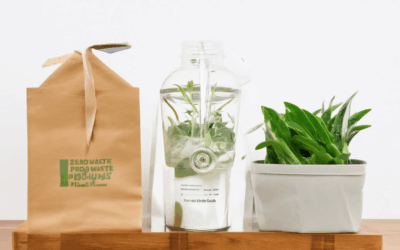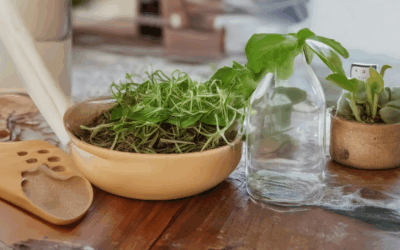Eco-friendly living has never been more prominent in today’s global conversation, with individuals and businesses alike seeking ways to reduce their environmental footprint. One of the most straightforward yet impactful ways to contribute to sustainability is through eco-friendly product swaps—small changes that can lead to significant long-term benefits. Whether it’s replacing single-use plastics with reusable alternatives or opting for products made from sustainable materials, every swap brings us closer to a healthier planet. In this article, we’ll explore the world of eco-friendly product swaps, delving into examples, strategies, and innovative packaging solutions that can transform daily life. From reducing waste to promoting sustainability, discover how simple swaps can make a big difference in preserving our environment for future generations.
Here are the key takeaways from the article:
- Adopt biodegradable materials to reduce plastic waste and support eco-friendly decomposition.
- Choose modular packaging for customizable solutions that minimize material use.
- Switch to refillable and reusable containers to promote a circular economy.
- Use sustainable plastic alternatives made from plant-based materials.
- Implement smart packaging with sensors to track product data and reduce waste.
- Utilize recycled materials to lower resource consumption and carbon footprint.
- Opt for compostable packaging to enhance waste management practices.
- Embrace minimal packaging design to reduce material waste.
- Invest in reusable packaging for long-term environmental benefits.
- Adopt sustainable printing techniques to minimize resource use and chemical exposure.
- Prioritize eco-friendly innovation to align with global sustainability goals.
- Gain long-term cost efficiencies through resource optimization.
- Build brand leadership by appealing to environmentally conscious consumers.

Examples of Eco-Friendly Products
- Kitchen Essentials
- Reusable Silicone Food Containers
- Bamboo Cutting Boards
- Ceramic Compostable Dishware
- Beeswax Wrap for Food Storage
- Bathroom & Personal Care
- Compostable Toilet Paper
- Sustainable Cotton Tampons
- Refillable Shampoo and Conditioner Bottles
- Eco-Friendly Toothbrushes
- Household Cleaning
- Plant-Based Laundry Detergent
- Microfiber Cleaning Cloths
- Non-Toxic Cleaning Sprays
- Reusable Cleaning Pads
- Personal Accessories
- Leather Tote Bags
- Cotton Reusable Straws
- Aluminum Water Bottles
- Woolen Socks
- Home Goods
- Rice Paper Tableware
- Bamboo Blinds and Curtains
- Recycled Plastic Furniture
- Upcycled Clothing Items
- Food Packaging
- Biodegradable Bubble Wrap
- Compostable Packaging Films
- Edible Seaweed Wraps
- Glass Food Jars
- Other Eco-Friendly Products
- Electric Kettles
- Solar-Powered Chargers
- Composting Bin
- Water Conservation Devices
What Are New Eco-Friendly Products?
Eco-friendly products are items designed with sustainability in mind, minimizing harm to the environment while maximizing functionality. These products cater to various aspects of daily life, from home essentials to fashion and technology.
At Eco Planeta Verde, we believe in promoting sustainable living through thoughtfully curated products that contribute positively to our planet. Here’s a look at some innovative and eco-conscious options:
- Bio-degradable Cleaning Products : Made from natural ingredients, these cleaners are safe for the environment and reduce plastic waste.
- Sustainable Fashion : Clothing made from organic materials like Tencel or recycled fabrics, reducing the carbon footprint of the textile industry.
- Zero-waste Kitchenware : Durable and eco-friendly alternatives to traditional plastics, perfect for reducing kitchen waste.
- Energy-Efficient Appliances : Smart devices that consume less energy, helping lower utility bills and reduce carbon emissions.
- Plant-based Personal Care : Products formulated with natural ingredients, free from harmful chemicals and packaged sustainably.
- Compostable Packaging : Materials that break down quickly in industrial composting facilities, reducing landfill waste.
- Water Conservation Hardware : Devices like smart sprinklers and rainwater harvesting systems to conserve water resources.
- Eco-friendly Building Materials : Sustainable materials like bamboo flooring and recycled concrete blocks for construction projects.
- Circular Economy Products : Items designed to last longer, encouraging repair and reuse rather than disposal.
To learn more about these products and discover additional eco-friendly options, visit our website . At Eco Planeta Verde, we’re committed to helping you make sustainable choices that make a difference.

Replacing Plastic with Eco-Friendly Products
Reducing plastic use is essential for protecting our planet. Here’s a comprehensive guide to replacing plastic with sustainable alternatives:
Daily Habits
- Reduce Single-Use Plastics: Minimize plastic bottles, wrappers, and disposable items. Opt for reusable water bottles, cloth bags, and eco-friendly containers.
- Choose Biodegradable Alternatives: Use paper, plant-based, or biodegradable products for items like food storage and cleaning supplies.
Household Essentials
- Replace Microbeads: Look for toothpaste and facial scrubs without microbeads, which are often plastic.
- Sustainable Cleaning Products: Use vinegar, baking soda, or natural cleaning solutions instead of plastic bottle cleaners.
- Recycled Products: Select items made from recycled materials to reduce the demand for new plastic production.
Food and Cooking
- Cling Film Alternatives: Use beeswax or silicone wraps instead of plastic wrap.
- Eco-Friendly Packaging: Support brands using compostable packaging for fruits, vegetables, and other foods.
- Cookware: Invest in ceramic, stainless steel, or cast iron cookware instead of plastic-coated versions.
Personal Care
- Plastic-Free Hygiene: Choose shampoo bars, solid perfumes, and toothbrushes made from natural materials.
- Bamboo Products: Use bamboo toothbrushes and combs to reduce plastic waste.
Transportation
- Public Transportation: Opt for buses, trains, or bikes to reduce reliance on plastic-emitting vehicles.
- Carpooling: Share rides to cut down on single-person car trips and associated plastic waste.
- Electric Vehicles: Consider electric cars or scooters for low-emission travel.
Waste Management
- Recycling and Composting: Separate recyclables and organic waste to minimize landfill contributions.
- Support Zero-Waste Initiatives: Participate in local programs aimed at reducing plastic waste.
Purchasing Habits
- Buy Less, Repair More: Extend product lifespans through repairs and maintenance.
- Second-Hand Market: Shop at thrift stores or online marketplaces to reduce new plastic production.
Advocacy
- Join Campaigns: Support movements against plastic pollution through petitions and social media campaigns.
- Local Cleanups: Volunteer for beach or river clean-up efforts to remove plastic debris.
Education and Awareness
- Stay Informed: Learn about the lifecycle of plastics and their environmental impacts.
- Share Knowledge: Educate friends and family about sustainable living practices.
- Collaborate: Work with schools, businesses, and community groups to promote eco-friendly habits.
By adopting these practices, we can collectively reduce plastic dependency and create a healthier planet for future generations.

Top 5 Innovative Eco-Friendly Packaging Ideas
Eco-friendly packaging is revolutionizing the way we consume goods, reducing waste, and minimizing environmental impact. Here are some cutting-edge concepts leading the charge:
- Biodegradable Materials: Packaging made from mushroom-based materials, hemp, and seaweed are gaining traction due to their rapid growth and low resource consumption. These materials break down naturally, eliminating the need for synthetic plastics.
- Modular Packaging: Customizable packaging solutions allow consumers to tailor their purchases, reducing unnecessary excess. Companies like Patagonia have successfully implemented this model, offering lightweight, adjustable packs perfect for outdoor adventures.
- Refillable and Reusable Containers: Brands are switching to glass and metal containers that can be refilled repeatedly. These options are not only durable but also recyclable, encouraging a circular economy approach. Look for products available at Reusable Products .
- Sustainable Plastic Alternatives: Plastics made from plant-based materials, such as polylactic acid (PLA), are becoming mainstream. These biodegradable plastics can be composted effectively, offering a greener alternative to traditional plastics.
- Smart Packaging: Advanced packaging solutions incorporate sensors and QR codes to track product freshness, expiration dates, and usage history. This technology helps reduce food waste and provides consumers with valuable information, as demonstrated by Walmart’s recent pilot program.
- Agricultural Residues: Packaging innovations are utilizing agricultural by-products, such as banana peels and rice husks, which are typically discarded. Converting these into eco-friendly packaging supports sustainable farming practices and reduces waste.
What is the Most Environmentally Friendly Packaging?
Eco-friendly packaging refers to materials and designs that minimize environmental impact throughout their lifecycle, from production to disposal. Here are some key aspects of environmentally friendly packaging:
- Recycled Materials: Packaging made from recycled materials reduces the demand for virgin resources, lowering energy consumption and carbon emissions. Many companies now use recycled paperboard for boxes and wrappers.
- Biodegradable Materials: Biodegradable packaging is made from natural materials that break down quickly in compost environments. Examples include mushroom-based packaging and plant-based plastics.
- Compostable Packaging: Compostable materials, like cornstarch-based bags, can be disposed of in home compost bins, reducing landfill waste.
- Minimal Packaging: Many brands are adopting minimalist packaging designs to reduce material use and waste. This includes using glass bottles instead of plastic and designing products to fit snugly for better space efficiency.
- Reusable Packaging: Reusable containers, such as glass jars and metal cans, are becoming popular for their longevity and reduced environmental footprint compared to single-use packaging.
- Waterless Printing and Vegetable-Based Inks: Advanced printing techniques, like waterless printing and vegetable-based inks, significantly reduce water usage and harmful chemical exposure during production.
Eco Planeta Verde advocates for these practices to promote sustainable consumerism and reduce our collective environmental impact. By supporting brands that prioritize eco-friendly packaging, we can work towards a more sustainable future.
For more information on sustainable packaging innovations and how to choose eco-friendly products, visit our sustainable living guide .

Eco-Friendly Innovation
Eco-friendly innovation refers to creative and sustainable approaches that aim to reduce environmental impact while delivering value. It involves developing new products, processes, or systems that align with ecological principles and contribute positively to the planet.
Why Eco-Friendly Innovation Matters
- Sustainability Goals : Businesses and individuals are increasingly prioritizing sustainability, driving the need for innovative solutions that minimize harm to the environment.
- Global Trends : With rising awareness of climate change, consumers and industries are seeking greener alternatives, making eco-friendly innovation essential for staying competitive.
- Long-Term Benefits : Eco-friendly innovations often lead to cost savings, improved efficiency, and stronger brand reputation, fostering trust and loyalty among environmentally conscious consumers.
Examples of Eco-Friendly Innovation
- Renewable Energy Technologies : Innovations like solar panels and wind turbines have revolutionized energy production, reducing reliance on fossil fuels.
- Circular Economy Models : Companies adopting circular economy principles recycle and repurpose materials, reducing waste and extending product lifecycles.
- Green Transportation : Electric vehicles (EVs) and public transit initiatives are transforming urban mobility, lowering emissions and promoting cleaner air.
- Sustainable Agriculture : Techniques like crop rotation and organic farming improve soil health and reduce chemical use, supporting eco-friendly practices.
Benefits of Eco-Friendly Innovation
- Environmental Protection : Reduces pollution, conserves resources, and lowers carbon footprints.
- Cost Efficiency : Often leads to long-term cost savings through resource optimization and reduced waste.
- Brand Leadership : Positions companies as leaders in sustainability, appealing to eco-conscious consumers.
Conclusion
Eco-friendly innovation is not just a trend—it’s a necessity for a sustainable future. By embracing innovative solutions, we can create a world that balances economic growth with environmental responsibility. Visit our site for more tips and resources on adopting eco-friendly practices: Eco Planeta Verde .




0 Comments